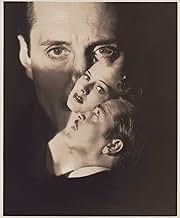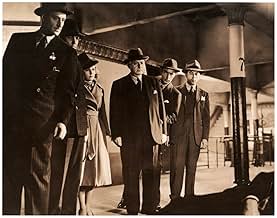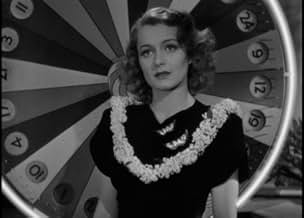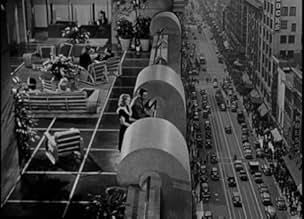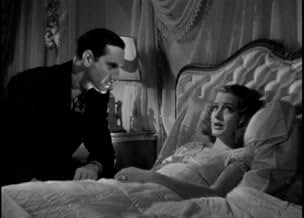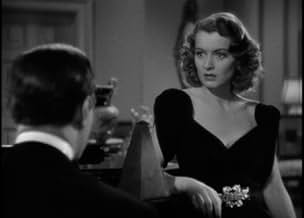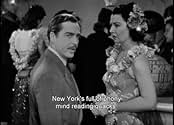A crazed physician marries a wealthy women and, with the help of his demented assistant, murders them for their money.A crazed physician marries a wealthy women and, with the help of his demented assistant, murders them for their money.A crazed physician marries a wealthy women and, with the help of his demented assistant, murders them for their money.
Barbara Jo Allen
- Louise Watkins
- (as Barbara Allen [Vera Vague])
Bobby Barber
- Bald Man in Library
- (uncredited)
William 'Billy' Benedict
- Mickey Barnes - Copy Boy
- (uncredited)
George Chandler
- Elevator Operator
- (uncredited)
Edward Earle
- Librarian
- (uncredited)
Chuck Hamilton
- Police Officer at Train Station
- (uncredited)
Sam Harris
- Passerby
- (uncredited)
Harry Hayden
- Ticket Clerk
- (uncredited)
Douglas Kennedy
- Hotel Clerk
- (uncredited)
Settar Körmükçü
- Dr. David Profesor
- (uncredited)
John Laing
- Intern
- (uncredited)
- Director
- Writer
- All cast & crew
- Production, box office & more at IMDbPro
Featured reviews
"Oh, there's no such thing as sanity. At it's best a heroic and precarious little hiding place in which we try to conceal ourselves from the devils...The devils of time, space, things unknown, and the past."
Although its title suggests conventional horror, "The Mad Doctor" is a pitch black thriller with some with some truly harrowing subject matter. Basil Rathbone plays Dr. Sebastien, a Bluebeard-like psychiatrist who recently killed off his wealthy wife Ida. After arousing the suspicion of local doctor Ralph Morgan, Rathbone leaves town. He soon finds his next mark, a deeply troubled young socialite named Linda that's been suffering with suicidal ideations.
Rathbone is accompanied in his efforts by Martin Kosleck as Maurice, a sort of male secretary. After seeing these two interact, it becomes very clear that they are more than criminal accomplices. When we see Kosleck in Rathbone's home or office, he's variously arranging flowers, spritzing himself with cologne, fussing with Rathbone over a choice of tie, and languorously sketching a black cat while wearing a bathrobe. When Rathbone starts to become genuinely interested in Linda, Kosleck responds with wounded jealousy.
This is very obviously a coded gay relationship, years ahead of the one in Hitchcock's "Rope." The scenes between Rathbone and Kosleck, both superb actors, positively crackle. In one scene, Rathbone gives a bone chilling monologue describing his contempt for dead wife Ida: "These atrocious paintings. This absurd wallpaper. These pathetic antiques. They all breathe her spirit. I can almost see her now coming down those stairs with that foolish smile and the love light in her eyes. I can never forgive her the eight months spent in this cave of romance."
The danger and intensity only ratchet up from there, climaxing in a truly haunting and beautifully executed ending. This is one of Basil Rathbone's most underrated films.
Although its title suggests conventional horror, "The Mad Doctor" is a pitch black thriller with some with some truly harrowing subject matter. Basil Rathbone plays Dr. Sebastien, a Bluebeard-like psychiatrist who recently killed off his wealthy wife Ida. After arousing the suspicion of local doctor Ralph Morgan, Rathbone leaves town. He soon finds his next mark, a deeply troubled young socialite named Linda that's been suffering with suicidal ideations.
Rathbone is accompanied in his efforts by Martin Kosleck as Maurice, a sort of male secretary. After seeing these two interact, it becomes very clear that they are more than criminal accomplices. When we see Kosleck in Rathbone's home or office, he's variously arranging flowers, spritzing himself with cologne, fussing with Rathbone over a choice of tie, and languorously sketching a black cat while wearing a bathrobe. When Rathbone starts to become genuinely interested in Linda, Kosleck responds with wounded jealousy.
This is very obviously a coded gay relationship, years ahead of the one in Hitchcock's "Rope." The scenes between Rathbone and Kosleck, both superb actors, positively crackle. In one scene, Rathbone gives a bone chilling monologue describing his contempt for dead wife Ida: "These atrocious paintings. This absurd wallpaper. These pathetic antiques. They all breathe her spirit. I can almost see her now coming down those stairs with that foolish smile and the love light in her eyes. I can never forgive her the eight months spent in this cave of romance."
The danger and intensity only ratchet up from there, climaxing in a truly haunting and beautifully executed ending. This is one of Basil Rathbone's most underrated films.
Quite a few reviews here have mentioned the ' relationship ' between Basil Rathbone's character and Martin Kosleck's character as being coded homosexuals. I thoroughly endorse this as I watched this film quite by accident on YouTube and I was surprised to see just how intimate in speech and gesture this couple were. The fact that they were both killers and that women had been murdered for their rich lifestyle reminded me of other homosexual killers in both ' Rope ' and ' Compulsion. ' and how somehow they got certificates in the UK admitting children with adults to see them. In the UK the film was called ' A Date with Destiny ' and not the horror signifier of ' The Mad Doctor ' which would have called out for an H certificate for adults only. Rathbone believes he has been saved from evil by falling in love with his last prospective victim, and his male partner, quite rightly becomes as righteously cross as an abandoned ' wife ' or ' husband. ' A Queer film indeed which has not as far as I can tell by historians of Queer and Gay cinema been noticed. America has been fiercely aggressive towards positive gay endings, even to today so any representation on screen of a possible gay character or two in a partner relationship has had to follow the tropes of abandonment, death or imprisonment. For a gay audience these negatives had to be also positives simply because homosexuality was overtly or implicitly seen on the screen. I could take a swipe at a few recent examples but I will concentrate on this 1941 film. Tim Whelan directs it well in Film Noir mode, and there are outstanding shots of New York during this period. The editing excellent and the acting exceptionally good, Ellen Drew as the last potential victim is perfect, shading her role from black mood to light laughter with professional expertise. I must mention Barbara Jo Allen as a friend who has a lot of great lines, delivered to perfection. A definite Paramount Eve Arden, lightening the film whenever she is in a scene. To sum up a taut thriller with touches of horror this deserves in my opinion a ten. A vastly underrated film on all levels. One final observation: the BBFC was very reluctant to give out H certificates during WW2, so that may explain the change of the film's title.
I remember seeing THE MAD DOCTOR on TV back in the early 1960s and although I didn't see it again until the release of this Blu-Ray half a century later, parts of it, especially the ending, had remained with me. Why this film has not made its bow on home video until now is beyond me. It's an A Movie, as can be seen by the big budget, but with B Movie sensibilities regarding its use of character players outside of Rathbone and its overall Film Noir look which is due to cinematographer Ted Tetzlaff. Even the title sounds like a B Movie. However the strongest element in the whole mix is the screenplay. More about that later.
The plot concerns a suave Svengali-like psychiatrist played by Rathbone who marries wealthy women and then disposes of them. He meets a wealthy socialite who has suicidal tendencies (Ellen Drew) and plans to make her his next victim. Can her reporter boyfriend (John Howard), whom she has rejected, save her in time? Nothing out of the ordinary there. What IS different in THE MAD DOCTOR is the relationship between Rathbone and his constant companion played by Martin Kosleck. It is clearly a gay relationship in everything but name and how it got past the 1940 censors is a question worth asking.
The screenplay was originally written by top writers Ben Hecht & Charles MacArthur in the early 1930s and intended for John Barrymore (hence the Svengali angle). It was originally called "The Monster" and later "Destiny". That explains the quality dialogue which is one of the movie's highlights. When Barrymore bowed out, the script sat on the shelf for 5 years before Paramount used it. They had changes made by Howard W. Green who received sole screen credit. Although full of dark moments, there is a lightness of touch from director Tim Whelan which adds to the enjoyment. Kino deserves credit for resurrecting this forgotten gem. Once you see it, you'll wonder why it stayed hidden for so long...For more reviews visit The Capsule Critic.
The plot concerns a suave Svengali-like psychiatrist played by Rathbone who marries wealthy women and then disposes of them. He meets a wealthy socialite who has suicidal tendencies (Ellen Drew) and plans to make her his next victim. Can her reporter boyfriend (John Howard), whom she has rejected, save her in time? Nothing out of the ordinary there. What IS different in THE MAD DOCTOR is the relationship between Rathbone and his constant companion played by Martin Kosleck. It is clearly a gay relationship in everything but name and how it got past the 1940 censors is a question worth asking.
The screenplay was originally written by top writers Ben Hecht & Charles MacArthur in the early 1930s and intended for John Barrymore (hence the Svengali angle). It was originally called "The Monster" and later "Destiny". That explains the quality dialogue which is one of the movie's highlights. When Barrymore bowed out, the script sat on the shelf for 5 years before Paramount used it. They had changes made by Howard W. Green who received sole screen credit. Although full of dark moments, there is a lightness of touch from director Tim Whelan which adds to the enjoyment. Kino deserves credit for resurrecting this forgotten gem. Once you see it, you'll wonder why it stayed hidden for so long...For more reviews visit The Capsule Critic.
The story begins with the deaths of one of Sebastian's wives. Her father is convinced that Sebastian is responsible...and during much of the film he works to bring the man to justice. But to counter the father, Sebastian has Gretz steal the body of his latest victim in order to prevent an autopsy! What else will these infamous killers do next?
Basil Rathbone plays the suave Bluebeard who uses his hypnotic powers over women, Dr. Sebastian. He marries rich women, murders them and then disappears....off to find another woman to kill. He's assisted in his endeavors by Gretz...and their relationship is VERY unusual (and nowadays it would be seen as homoerotic by many). I would love to see a remake that explores this odd relationship more. Regardless, it is an interesting little suspense picture...well worth seeing because of the acting and script.
Basil Rathbone plays the suave Bluebeard who uses his hypnotic powers over women, Dr. Sebastian. He marries rich women, murders them and then disappears....off to find another woman to kill. He's assisted in his endeavors by Gretz...and their relationship is VERY unusual (and nowadays it would be seen as homoerotic by many). I would love to see a remake that explores this odd relationship more. Regardless, it is an interesting little suspense picture...well worth seeing because of the acting and script.
There is something really quite sinister to Basil Rathbone's title performance in this rather intimidating psychological thriller. We know from the outset that he has disposed of his wife "Ida" - ostensibly pneumonia - but the local physician "Dr. Downer" (Ralph Morgan) is suspicious. Shortly after cleaning up on the inheritance, he moves with his friend "Maurice" (Martin Kosleck) to start afresh. Now you don't have to be Einstein to recognise that these two men are more than just roomies, and that causes a bit of consternation when "Dr. Sebastian" finds new prey. This time, in the guise of the deeply troubled "Linda" (Ellen Drew). With a marriage and a trip to Quito on the cards, might history be about to repeat itself? Well, fortunately for "Linda" reporter "Sawyer" (John Howard) is also a bit suspicious of the man, and after a bit of investigation and a chat with "Downer", the two begin to piece together quite a different persona for Rathbone than the one he has been successful peddling thus far. Can they act in time to thwart his malevolent plan? Tim Whelan allows his star to exude menace here. The script is really only adequate, but the pace is good and the gradually accumulating sense of peril - and a wonderfully seedy contribution from the increasingly envious "Maurice" leads us towards a conclusion where nothing is predictable. Actually, on that front I was a little disappointed, but all in all, this is a dark and effective tale of manipulation that is well worth a watch.
Did you know
- TriviaOne of over 700 Paramount Productions, filmed between 1929 and 1949, which were sold to MCA/Universal in 1958 for television distribution, and have been owned and controlled by Universal ever since; its earliest documented telecast took place in Seattle Monday 11 May 1959 on KIRO (Channel 7).
- GoofsAt the Library, Sebastien shades over a page with a pencil to see the impression of what was written there earlier but when he tears the page off the pad, the page is untouched.
- Quotes
Maurice Gretz: You're like all the other clever ones, clever until they meet a woman, and then they suddenly become fools.
- ConnectionsReferenced in Svengoolie: Night Monster (2015)
- SoundtracksAloha 'Oe
Music by Queen Liliuokalani
- How long is The Mad Doctor?Powered by Alexa
Details
- Runtime1 hour 30 minutes
- Color
- Aspect ratio
- 1.37 : 1
Contribute to this page
Suggest an edit or add missing content


